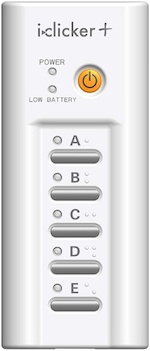Enhanced i>clicker+ with Braille Buttons Set for Fall Rollout

i>clicker+ will add an improved keypad with Braille characters. |
Macmillan New Ventures' i>clicker unit is rolling out an enhanced version of its student response device this fall.
i>clicker is a line of classroom response devices for K-12 and higher education that includes the original i>clicker, the LCD i>clicker 2, and the web>clicker mobile edition for iOS, Android, Blackberry, and webOS. Those devices work with the core i>clicker software to deliver formative assessments, polls, and other types of classroom interactions between instructors and students. The free desktop software for Mac OS X and Windows includes graphing capabilities and other forms of poll data management, anonymous polling, satellite polling, PowerPoint support, gradebook, and Excel export, among other features. The software integrates with major learning management systems, including Blackboard, Angel, WebCT, Desire2Learn, Sakai, and Moodle.
The new version of the classroom clicker is designed along the same lines as the original i>clicker remote. It lacks the LCD screen of the higher-end i>clicker 2 but will be designed to match more closely the look and feel of the i>clicker 2, according to the company.
The new model will be smaller than the original, measuring 4.65" (L) x 1.98" (W) x 0.67" (D) and weighing in at 2.9 ounces. Enhancements coming to the i>clicker+ include:
- Braille characters on the A through E buttons;
- Improved labeling of buttons;
- A recessed power button;
- LED lights adjacent to each button for poll confirmation; and
- Two AAA battery operation (down from three batteries).
The i>clicker+ is expected to ship in October 2012. Pricing has not been announced. Additional details are available on i>clicker's site.